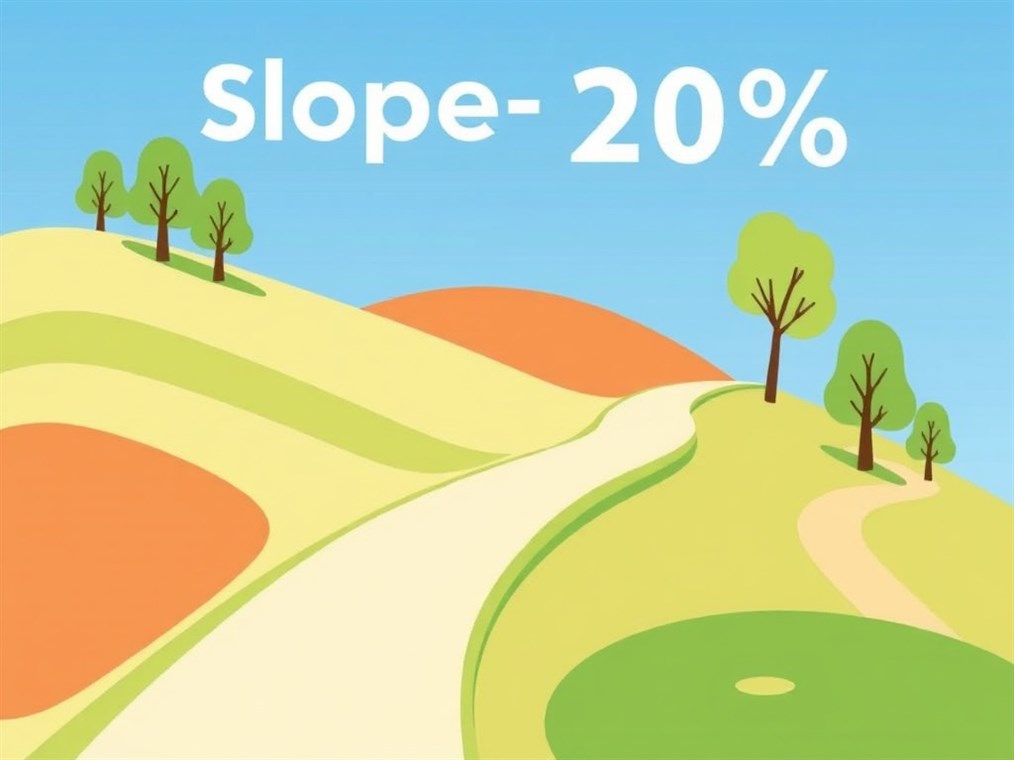
Decoding Slope Percentage: It’s More Than Just a Number
FactsDecoding Slope Percentage: It’s More Than Just a Number
Ever wonder how they figure out how steep a road is, or how to make sure a ramp isn’t too crazy for a wheelchair? The answer, in many cases, boils down to something called slope percentage. It’s a simple idea, really, but it pops up everywhere – from building design and hiking trails to serious stuff like environmental science and road construction. So, what exactly is slope percentage? Let’s break it down.
Basically, slope percentage is just a fancy way of saying how much something goes up (or down!) for every 100 steps you take forward. Think of it like this: for every football field you walk, how many feet do you climb? That’s the essence of slope percentage. It’s all about measuring that change in height over a certain distance.
The math is pretty simple, thankfully:
Slope Percentage = (Rise / Run) x 100
“Rise” is just the vertical distance – how much higher or lower you are at the end. “Run” is the horizontal distance – how far you walked to get there. Multiply the whole thing by 100, and boom, you’ve got your slope percentage. So, if you climb 5 feet for every 100 feet you walk forward, that’s a 5% slope. Easy peasy.
Now, here’s where things get a little trickier. You might also hear about slope in terms of degrees. Degrees are just another way to measure angles, and they’re related to slope percentage, but they’re not the same thing. A 45-degree angle, for instance, is a 100% slope – meaning you’re going up just as much as you’re going forward. To go from degrees to percentage, you need a little trigonometry (remember that from high school?). The formula is: Slope Percentage = tan(angle in degrees) x 100. And going the other way? Angle in degrees = arctan(Slope Percentage/100). The key takeaway? Don’t mix them up! A 10% slope isn’t the same as a 10-degree slope. Trust me, you don’t want to get that wrong when you’re building a ramp.
Where does all this slope percentage stuff actually matter? Everywhere!
- Roads: Civil engineers use it to design roads that aren’t too steep for cars to climb.
- Buildings: Architects use it for roofs, ramps, and making sure water flows away from buildings properly. Speaking of ramps, the Americans with Disabilities Act (ADA) sets strict rules for ramp slopes to make sure they’re accessible to everyone. They usually cap it around 8.33%.
- Landscapes: Landscape architects use it to design gardens and drainage systems.
- The Great Outdoors: Hikers and skiers use it (without even realizing it!) to gauge how tough a trail or slope will be.
- Construction: Builders use it to make sure concrete slabs are level and roofs have the right pitch.
Understanding slope percentage isn’t just about numbers; it’s about safety. A too-steep road can be dangerous, especially in bad weather. Construction workers need to be extra careful on steep slopes to avoid accidents. And knowing the slope of a hiking trail can help you decide if you’re up for the challenge. I remember one time, I underestimated a “moderate” trail… let’s just say I learned a lot about slope percentage that day!
So, there you have it. Slope percentage: a simple concept with surprisingly wide-ranging applications. Whether you’re designing a building, hitting the slopes, or just trying to figure out if that hill is really as steep as it looks, understanding slope percentage can make all the difference. It’s a tool that helps us navigate and shape the world around us, one degree (or percentage!) at a time. And hopefully, now you’re a little better equipped to do just that.
You may also like
Disclaimer
Categories
- Climate & Climate Zones
- Data & Analysis
- Earth Science
- Energy & Resources
- Facts
- General Knowledge & Education
- Geology & Landform
- Hiking & Activities
- Historical Aspects
- Human Impact
- Modeling & Prediction
- Natural Environments
- Outdoor Gear
- Polar & Ice Regions
- Regional Specifics
- Review
- Safety & Hazards
- Software & Programming
- Space & Navigation
- Storage
- Water Bodies
- Weather & Forecasts
- Wildlife & Biology
New Posts
- Diving Deep into Tangerine: More Than Just a Sunny Locale
- Jamaica Backpack Daypack Pockets Shopping – Review
- TEOYETTSF Climbing Backpack Multifunction Military – Buying Guide
- The Curious Case of Cavendish’s Classroom: Where Did This Science Star Study?
- Dragon Backpack Insulated Shoulder Daypack – Buying Guide
- ROCKY Hi-Wire Western Boots: A Rugged Review After a Month on the Ranch
- Vertical Curbs: More Than Just Concrete Barriers
- Regatta Modern Mens Amble Boots – Honest Review
- YMGSCC Microfiber Leather Sandals: Beach to Boardwalk, Did They Hold Up?
- Tangier: More Than Just a Backdrop in “Tangerine”
- DJUETRUI Water Shoes: Dive In or Doggy Paddle? A Hands-On Review
- Barefoot Yellow Pattern Hiking 12women – Is It Worth Buying?
- Koa Trees: How Fast Do These Hawaiian Giants Really Grow?
- DDTKLSNV Bucket Hat: Is This Packable Sun Shield Worth the Hype?